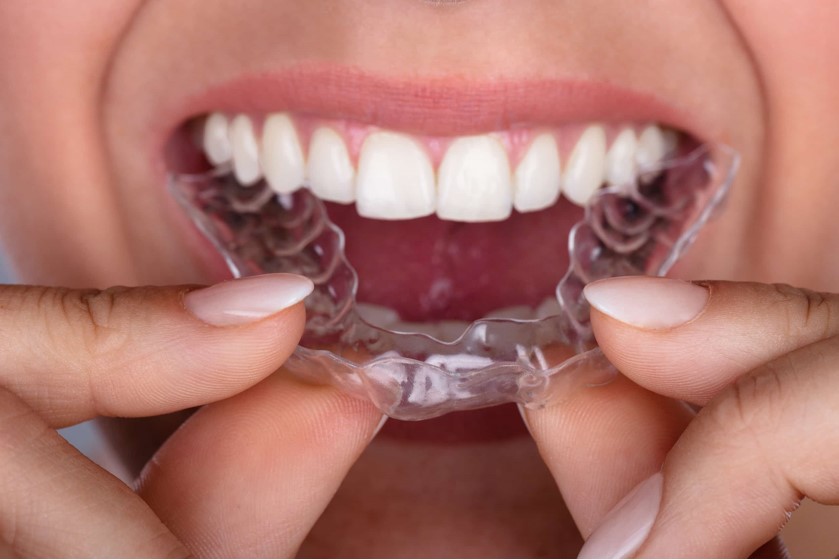Dental & Smile
Dental clinic in Noida
Absolute wellness is the clinic that is one of the best dental clinic in Noida providing all types of dental care to their patients. The clinic is listed as one of the best clinic for all your dental needs. It is a one stop solution for all your dental related problems.
I. DENTAL VEENERS
Dental veneers are custom, tooth-colored shells that fit over the front of your teeth. The purpose of veneers is to change the shape, color, size, and appearance of natural teeth.
In cosmetic dentistry, veneers are sometimes referred to as a “smile makeover.”

Veneers are most commonly placed over front teeth, rather than back molars. The shells fix chipped teeth, different-sized teeth, slightly crooked teeth, and tooth discoloration. Veneers cannot replace missing teeth.
II. TEETH WHITENING
ZOOM Advanced 1Hr Teeth Whitening
The Zoom In-Office Whitening System is a revolutionary tooth whitening procedure. It is safe, effective and fast . In just under one hour, your teeth will become many shades whiter. This advanced whitening treatment procedure give reliable and long-lasting results.
Your smile is important. It’s one of the first things you notice when you meet someone. Everybody wants a whiter, brighter smile which makes one beautiful, it can help you feel better about yourself and make a memorable impression.
Benefits :
- Convenient
- Long-lasting
- Low post-op sensitivity
- Proven to be Safe and Effective
- Performed by a dental professional
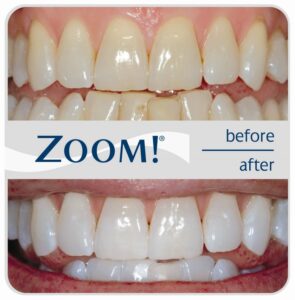
III. FULL MOUTH REHABILIATION
What Full Mouth Rehabilitation Is
When your dentist informs you that you’re a good candidate for full mouth reconstruction, it’s usually because you need several procedures in order to get your gums and teeth back in working order.
Often problems such as damaged teeth, improperly seated jaw joints, missing teeth, faulty bites, jawbone and gum damage, worn-out dental work, and even diseases of the mouth all need to be addressed.
While each of these procedures can be performed independently, when several of them exist at once, full mouth rehabilitation is often advised.
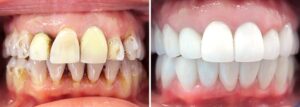
IV. LASER DENTISTRY
Laser dentistry is the use of lasers to treat a number of different dental conditions. It became commercially used in clinical dental practice for procedures involving tooth tissue in 1989.
Laser dentistry potentially offers a more comfortable treatment option for a number of dental procedures involving hard or soft tissue compared to drills and other non-laser tools.
LASER stands for “light amplification by the stimulated emission of radiation.” The instrument creates light energy in a very narrow and focused beam. This laser light produces a reaction when it hits tissue, allowing it to remove or shape the tissue.
Laser dentistry is used in a variety of procedures, including:
- treating hypersensitivity
- treating tooth decay
- treating gum disease
- whitening teeth
Lasers can make dental treatments more efficient, cost effective, and comfortable. The Food and Drug Administration (FDA) has approved laser dentistry as a treatment option for several dental conditions.
V. DENTAL BRIDGE
A dental bridge is a permanent appliance that replaces a missing tooth or missing teeth. It’s made up of several pieces that are fused together to fit into the open space where your tooth or teeth used to be.1
Dental bridges are an alternative to partial dentures. They serve both practical and aesthetic purposes, enabling you to eat and speak better as well as restoring your teeth’s appearance.
The bridge may be made of several different types of material, including gold, alloys, or porcelain. When replacing a front tooth, porcelain is most often the material of choice because it can be matched to your natural tooth color.
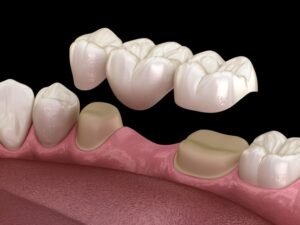
VI. TOOTH FILLINGS
Dental Filling is a treatment modality to restore missing tooth structure which could have been a result of decay or trauma. Decay makes tooth hollow. Dental Filling helps to fill this gap and protect it from further decay. A filling is also used to repair broken or cracked tooth and the teeth which wear off due to dental habits like teeth grinding, nail biting etc.
Tooth Coloured Filling
When does one need dental filling ?
There are various signs and symptoms where fillings can be required. The symptoms could be as below:
- A hole in your tooth
- Dark spots on the tooth
- Food stuck between certain areas of the teeth
- Chipped or broken tooth
- Sensitivity to hot and cold food and beverage
- Single or multiple cavities
If you come across any of the symptoms as mentioned above, then there is a chance that you need a filling. The final decision will be of your dentist after a thorough oral examination.
VII. TEETH CLEANING
One of the most underestimated processes that we do in our daily lives is undoubtedly the cleaning of the teeth. According to many researches, it is found that people often do not clean their teeth properly. In most of the cases, their cleaning techniques and patterns do more damage than good. People always wonder why they have dental problems in spite of proper cleaning.
It is mandatory to have regular sessions with your dentist to get your teeth cleaned. Most of the dentists would advise you to come for the cleaning procedures once in every six months. The cleaning techniques involve pain, jaw pain and prodding. You can check with your dentist if you have any query about the procedure and they will guide you properly.
VIII. TOOTH EXTRACTION
A tooth extraction is the removal of a tooth.
Dentists and oral surgeons remove teeth for various reasons. Some examples include:
- dental cavities
- gum disease
- dental infections
- trauma or injury to the tooth or surrounding bone
- wisdom teeth complications
- preparation for a dental prosthesis
- preparation for dental braces, if the teeth are very crowded
- baby teeth not falling out at the proper age
IX. DENTURES
A denture is a removable replacement for missing teeth and surrounding tissues. Two types of dentures are available — complete and partial dentures. Complete dentures are used when all the teeth are missing, while partial dentures are used when some natural teeth remain.
a) Complete Dentures
Complete dentures can be either “conventional” or “immediate.” Made after the teeth have been removed and the gum tissue has begun to heal, a conventional denture is ready for placement in the mouth about eight to 12 weeks after the teeth have been removed.
Unlike conventional dentures, immediate dentures are made in advance and can be positioned as soon as the teeth are removed. As a result, the wearer does not have to be without teeth during the healing period. However, bones and gums shrink over time, especially during the healing period following tooth removal. Therefore a disadvantage of immediate dentures compared with conventional dentures is that they require more adjustments to fit properly during the healing process and generally should only be considered a temporary solution until conventional dentures can be made.
b) Partial Dentures
A removable partial denture or bridge usually consists of replacement teeth attached to a pink or gum-colored plastic base, which is sometimes connected by metal framework that holds the denture in place in the mouth. Partial dentures are used when one or more natural teeth remain in the upper or lower jaw. A fixed bridge replaces one or more teeth by placing crowns on the teeth on either side of the space and attaching artificial teeth to them. This “bridge” is then cemented into place. Not only does a partial denture fill in the spaces created by missing teeth, it prevents other teeth from changing position. A precision partial denture is removable and has internal attachments rather than clasps that attach to the adjacent crowns. This is a more natural-looking appliance.
X. DENTAL CROWNS
Dental crowns are caps placed on top of damaged teeth. Crowns are used to protect, cover and restore the shape of your teeth when fillings don’t solve the problem. Dental crowns can be made out of metals, porcelain, resin and ceramics. They typically don’t require special care over time other than regular good oral hygiene.
Over time, your teeth can get damaged. This can happen for a variety of reasons, like tooth decay, injuries or just use over time. Your teeth can lose their shape or size. Dental crowns are tooth-shaped “caps” that can be placed over your tooth. Think of it like a snug hat for your tooth. The crown restores the tooth’s shape, size, strength and appearance.
The dental crown is cemented into place on your tooth and it covers the visible portion of the tooth.
Why would I need a dental crown?
You may need a dental crown for several reasons, including:
- Protecting a weak tooth (possibly from decay) from breaking or to keep the weak tooth together if parts of it are cracked.
- Restoring a broken tooth or a severely worn down tooth.
- Covering and supporting a tooth with a large filling and not much tooth remaining.
- Holding a dental bridge in place.
- Covering misshapen or severely discolored teeth.
- Covering a dental implant.
- Covering a tooth that’s been treated with a root canal.

XI. COSMETIC DENTISTRY
Cosmetic dentistry, also known as esthetic dentistry, has not been clearly defined by the American Dental Association (ADA). However, dentistry define it as the method of dentistry that improves a patient’s smile and self-image. Having a beautiful smile and strong teeth are essential for many reasons—aesthetically and in relation to overall health.
An attractive smile, or lack thereof, affects your oral health. In addition, self-confidence and how the world perceives you on the outside are also impacted. This is because a person’s smile is usually the first feature anyone notices.
Esthetic procedures include dental veneers and teeth whitening On the other hand, dental crowns, dental bridges, and dentures are all restorative dental treatments.
XII. BRACES AND CLEAR ALIGNERS
Braces and clear aligners are orthodontic treatments, but they are also considered cosmetic by nature. This is because most people who invest in braces or clear aligners, such as Invisalign, do so to improve their appearance. In some cases, braces or clear aligners may be medically necessary.

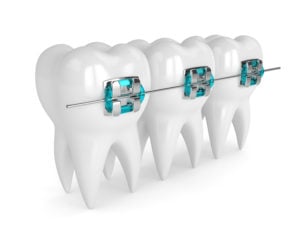
Both devices put pressure on your teeth, which moves them into the correct positions over time. Children and teens often get traditional metal braces, while adults typically get clear braces or aligners because they are less noticeable.
XIII. GUM CONTOURING
Gum contouring is another cosmetic procedure that changes the shape of your gums. During the procedure, a dentist cuts away any excessive gum tissue that is causing a “gummy” smile. A gummy smile is when a person has too much gum tissue above their top teeth. Contouring can also be used to restore exposed teeth caused by receding gum tissue.
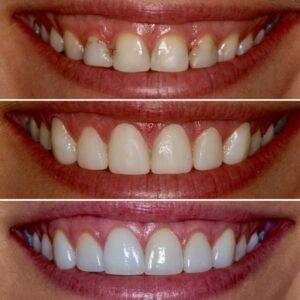
XIV. DENTAL IMPLANTS
A dental implant is a surgical fixture that is placed into the jawbone and allowed to fuse with the bone over the span of a few months. The dental implant acts as a replacement for the root of a missing tooth. In turn, this “artificial tooth root” serves to hold a replacement tooth or bridge. Having a dental implant fused to the jawbone is the closest thing to mimicking a natural tooth because it stands on its own without affecting the nearby teeth and has great stability. The process of fusion between the dental implant and jawbone is called “osseointegration.” Most dental implants are made of titanium, which allows them to integrate with bone without being recognized as a foreign object in our body. Over time, technology and science have progressed to greatly improve the outcomes of dental implant placement. Today, the success rate for dental implants is close to 98%.
Dental implants are replacement tooth roots made of titanium. Implants provide a strong foundation for fixed (permanent) or removable replacement teeth that are made to match your natural teeth. Instead of individual crowns, some patients may have attachments on their implant that support a removable denture.

XV. ROOT CANAL THERAPY
Root canal treatment is designed to eliminate bacteria from the infected root canal, prevent reinfection of the tooth and save the natural tooth. When one undergoes a root canal, the inflamed or infected pulp is removed and the inside of the tooth is carefully cleaned and disinfected, then filled and sealed.
Inside your tooth, beneath the white enamel and a hard layer called dentin, is a soft tissue called pulp. This tissue contains blood vessels, nerves and connective tissue, which help grow the root of your tooth during its development. A fully developed tooth can survive without the pulp because the tooth continues to be nourished by the tissues surrounding it.
A modern root canal treatment is nothing like those old sayings! It’s very similar to a routine filling and can usually be completed in one or two appointments, depending on the condition of your tooth and your personal circumstances. Getting a root canal is relatively painless and extremely effective. You’ll be back to smiling, biting and chewing with ease in no time.
Saving the natural tooth with root canal treatment has many advantages:
- Efficient chewing
- Normal biting force and sensation
- Natural appearance
- Protects other teeth from excessive wear or strain
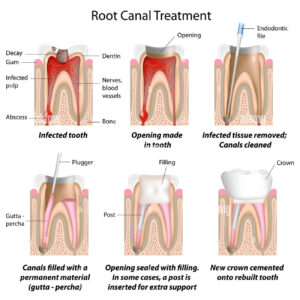
Flexible appointments
Or call — 8595079766

